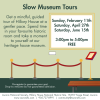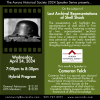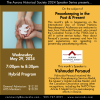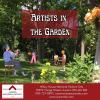McIntyre, John (2015) Transcript
January 31, 2015
Transcription: John McIntyre(JM), interviewed by Heba Shahaed (HS)
HS: I am Heba Shahaed interviewing John McIntyre today, January 31st, 2015. Hi John.
JM: Hello
HS: So, how long have you been in Aurora for?
JM: Well, I’ve lived here all my life, or at least all of my life so far, except for time when I was away at University and at Graduate School, and so really most of my life.
HS: Wow, so what is your involvement with the historical society?
JM: Well, currently I’m president of the historical society but I’ve been involved, well I guess since I guess the late, the late 1960s. I remember doing an exhibit in, I think it was 1968 or 1969 for the historical society in a store front in the centre of Aurora, and I became a member of the board at that time too, and was involved in the organization of the very first Aurora Museum in the old Aurora waterworks building which opened back in 1973. And that was the start of the museum and I served as volunteer curator along with Don Webster who was a cousin of mine, and so when the museum began I was very much involved in that. And then in the move to the Church Street School, which is now the Cultural Centre, that’s where the museum was, and we moved there in 1981. And then the historical society acquired Hillary House in 1981 an I was part of that too. And… I’m not sure where Italo is going to go, but anyway, here he is. And so I guess all along I’ve been involved in the historical society one way or the other.
HS: Wow, so what do you think has been, like your, the number one thing that you’ve done for the Aurora Historical Society that’s like, the most memorable for you?
JM: Well I think it was certainly the work with the collection to establish, or help establish the collection in the early years and have a home for it, as I say first of all, in the old Aurora Waterworks Building where Park Place Manor is today actually. And then, I was very much part of the crusade to save the Church Street School from demolition and to move the museum there and worked with local officials like John West who was a councilor at that time, and later mayor, he was very much involved in that campaign. And so the successful moving of the museum to the Cultural Centre in 1981 and then the acquisition of Hillary House in 1981, because that house could have been demolished, it could have been lost to the community if the historical society hadn’t stepped forward at that time. So I think those would be, probably the most important things that I’ve been involved with and then since that time trying to do what I can to make sure that the museum is successful and that Hillary House National Historic Site is successful.
HS: And what do you plan to do in the future with the historical society?
JM: Well, of course the historical society is changing and evolving, the Town of Aurora now looks after the museum, and so the Hillary House, and so the historical society is focused on Hillary House. But I hope that still it will be the Aurora Historical Society that will be concerned about all the history of Aurora, not just at Hillary House. And it’s a real challenge for a relatively small organization to own a property like Hillary House, to maintain a property, to operate it as a museum and fewer and fewer organizations are doing that now; it’s by and large government agencies that run museums. So I hope over the next few years we’ll be able to strengthen the historical society’s fundraising and it’s resources so that it can be a very good steward of Aurora’s history.
HS: Now, I know that you’ve been living here for almost all your life, so what school did you go to?
JM: Well, started out at the Wells Street School, which is now being turned into condominiums actually, that was where I started kindergarten and part of grade one, and then when I was about half way through grade one George Street School was ready, so I moved over to George Street School. And I remember that, I remember that first day when the first classes were there and it seemed like such a wonderful, modern, new school and of course now, here we are in 2015 and I hear that George Street School is going to be closing fairly soon also. So I was there and then George Street went up only to grade seven at that time, so I went back to Wells Street for grade eight, and then to Williams for high school.
HS: That sounds like fun, so many schools
JM: Well, it’s sort of back and forth from Wells Street to George Street and back again to Wells Street, but…
HS: So what did you enjoy doing as a child, like, did you have any favourite places to go or something you enjoyed doing?
JM: Well I think it, at that time you know, going just a few blocks seemed like a big adventure. I mean we would, I mean I, as you said I lived in the same place for a good part of my life which is right here on Yonge Street, which is right at the corner of Yonge and Irwin, and a lot of my friends lived on Irwin Avenue which is the street just to the south of my house and beyond Irwin Avenue, to the west there was a creek, and beyond the creek is what is now, Fleury Park; but when I was growing up, going across the creek was a, I mean it was a huge adventure you know. If we were going across the creek it was assumed that we’d be sort of packing a lunch and going over there and it would be like going into this wilderness you know, this very exciting place. And now I look at it you know, and it’s really only about two or three blocks away, but then it was an adventure because the park hadn’t been opened up yet and so when you crossed the creek there wasn’t a bridge so you’d be crossing on stones and that sort of thing. And so it was an adventure but you know, sometimes we think of those times as idyllic but I remember we would look at the fish that were in that creek and the fish often had these really grotesque, growths on them, these tumors, really. That was because of the Tannery in Aurora, which was one of the big industries, and of course that building has just been torn down early in this year, 2015, and it provided work for a lot of people, including the father of one of my best friends, but it would regularly discharge all sorts of chemicals into the water and presumably the ground as well. And we didn’t know at that time, we thought it was funny if the creek turned blue, or if the creek turned this strange colour green, but it was all the chemicals in it. And then we saw the fish and you know, we just thought it was really strange and didn’t realize what was really happening. Certainly we’re a lot more aware of pollution now. So in a way it sort of sounds idyllic and very rural, but even at that time there were some problems.
HS: Yea, so what other big industries were in Aurora at that time?
JM: Well, I mean, during my childhood I remember when Sterling Drug arrived in Aurora, I mean that was the biggest industry at Yonge Street and Murray Drive, where the Canadian Tire store is now. I mean, Sterling Drug made Bayer Aspirin and Phillips Milk of Magnesia, there were all of these big name medicines that came out of Sterling Drug and so that was the big new industry of my childhood, and when people looked at that building we thought, oh that’s going to be here forever, and yet that’s one of the many things that has changed dramatically because it turned out they were here for what, maybe twenty-five years or something like that and that was a good, long time and a lot of people found employment there, but then, then they closed and I think moved back to the United States because they had been an American company to start with. So that was a big, it was a big thing when they arrived in town, cause they were the biggest industry by far, then when they left the town, later, you know it was another big thing, difficult.
HS: Right, so you’ve been living in this house for a large portion of your life, is that right? So how has this house kind of like, changed, or like grown with you? Do you have any special memories?
JM: Well it was built in 1875 and then my grandparents bought the house in 1901, so they were the second family to own the house, so as of this year it’s been in my family for a hundred and fourteen years. So my grandparents bought it and, they had, they had both looked at this house and wanted to buy it for quite a while before they actually did and they rented a house about a block away when they were married in 1899 and they rented that house, partly so they could keep an eye on this one, so that if it came up for sale, or if they heard anything about it coming up for sale they would be the first people to put in an offer on it. And so that’s what they did, about two years after they moved into their rented house, Mrs. Robinson, who at that time was the widow of Dr. Robinson who’d built the house, had put the house up for sale, and so they purchased it and it was a big decision because they were not, they were not wealthy by any means, but they furnished the house with, what to them was used furniture, and then today people look at that as antiques, they were buying used furniture just to fill the house. And so they lived here and they raised two daughters here, one of them being my mother, Margaret Webster, and then when my mother married William McIntyre in 1950 they decided that they would continue to live here, and then I was born here and my sister was born here. So as I say, I grew up here, went away to university, lived elsewhere for a while. I think Italo’s gonna go down now.
HS: Okay,
JM: And then, ultimately came back, and so, it hasn’t changed all that much, I mean a lot of other houses were being modernized over the years, and certainly changes were made over time, but not a lot of major changes were done. I think it was always because the house was so big maybe nobody could afford to make big changes and big modernizations, which is good today because I think people value history a little bit more, and tradition a little bit more, and so it hasn’t changed that much at all.
HS: I know, this house is in such great condition too.
JM: Well, it seems to be, for the most part yes.
HS: Have you had like, any special memories in this house?
JM: Well, I mean all the memories of you know, of growing up, I mean when I was growing up my, my grandmother was still living and she passed away in 1964 and actually I remember when she was interviewed by the historical society. So somewhere, and somewhere there is a tape of my grandmother being interviewed. And she, I think, shaped a lot of my interest in history because I grew up asking her about, you know what was life like in the “olden days” as I thought of them. She’d been born in 1875 and so, in a way that means that when I think back I can in a way picture what life would’ve been like well over, well, what’s that 130 years ago, 135 years ago, because she would talk about growing up in this community, because she grew up here and her, her family had lived here for several generations. I mean, today Aurora has preserved the Petch Log House, which is near the Town Hall, and some of my ancestors actually built that house. So, they were among the pioneers, and my grandmother had a sense of history and the importance of history and liked to talk about the olden days, and so she, she sparked my interest in history.
HS: So does that house still exisit over there?
JM: The Petch Log House?
HS: The Petch Log House
JM: Yeah, it’s, it was originally located where, well where the Best Buy store is now, at the, at, on the hill near 404 and Wellington. And when that development was created, the town made a deal with the developers that the house would be dismantled, or at least it would be moved, and the developers provided some money for the restoration. It took a number of years actually, before the town decided what they wanted to do with it, and still in 2015 they’re deciding what they’re going to do with it in the future, but then n they rebuilt it, next to the Town Hall.
HS: And is that also kind of like the Hillary House, containing lots of…
JM: It’s empty actually, right now, and so again it’s future use is still something that the town is considering now. But what it does do, is it shows the, some of the traditional construction methods and also the massive size of timber that was here, that was cut and then used in constructing log buildings.
HS: Wow, so in 2003, I believe, you were the Aurora Citizen of the Year?
JM: That’s right.
HS: So, would you like to tell us about that?
JM: Well, it was a, well it was a complete surprise, it was a great, a great honour and I, I mean I didn’t know anything about it. A friend of mine asked me if I would go out for dinner that evening and I for get how exactly it worked, worked out, but then I found that we weren’t really going to dinner, that she was taking me over to the Town Hall, and then it all sort of, happened, over there. So I was certainly surprised, and it was certainly an honour, because there had been a lot of people who have contributed a lot over time to the community, so it was both an honour and a surprise.
HS: So why do you believe that you were nominated?
JM: Well, I think it was largely my work with the museum,, and with the preservation of Hillary House. And then I had written a book called Aurora: A History in Pictures and I did that to make sure that some of the pictures which the historical society gathered together would, would have a wider audience and so that came out in 1988 and there was a reprinting of that, thanks to Ron Wallace, here in Aurora about ten years after that, and now that’s out of print, but there’s still people who ask about it, and of course people who refer to it because it’s still available through the library and that sort of thing.
HS: Yeah, so like so what does it talk about? Like everything that’s happened in Aurora?
JM: Well, it’s based on historic photographs and also some maps and some plans, so the earliest, well the earliest of the maps goes back to the 1850s, and then the latest of the pictures would come up to the time of World War Two. So, I mean if you just provide people with a book of words and some will be interested in reading the book and so on, but I thought that having a book that was primarily of pictures with some interesting captions and stories, that would capture more peoples imagination and that would be of more interest to young people who might not just wanna read through page after page of words, but might be inspired by the pictures and might ask questions when they saw the pictures, that sort of thing.
HS: Yea, so like, while doing research, collecting the photographs, how do you feel Aurora has changed over the years?
JM: Well, I mean certainly as everyone says it’s so much bigger, but you know I remember when I was, when I was growing up, the time of Aurora’s centennial in 1963, that was the time when Aurora’s population first hit 10,000 people. And people felt that that was a huge change, because in a very short period of time, in really, I think really less than ten years, Aurora had grown from only about 3,500 up to 10,000. So in a way that’s, that’s 300% in less than ten years. So we have grown a lot more in the last forty years, but it’s actually been slower than what happened in the fifties and early sixties. I mean that was an explosive growth there at that time, and I remember in 1963 people were saying, you know, how can you, there were three parts to the town. There was the old part of town and then to the north was Aurora Heights and to the south was Regency Acres and the big discussion was then that, you know, all these new people, how are you going to integrate them? But now today people think of that as part of the older part of town. So how do you then integrate people who are living east of Bayiew for instance and so it’s a process that I think the town’s been dealing with for a long time. I mean, how do you make people who haven’t lived in the community for a long time, how do you make them feel as if this is their, this is their home. And so, it’s a, you know, it can be a challenge now as it was a challenge then. But I don’t think it’s anything that’s completely new to Aurora. I think probably the biggest challenge to Aurora’s identity now is more the proximity to Toronto and so many people work outside of Aurora so they may not identify with the community as much today as people who would, they would not only live here, but they would work here, and they would do all their shopping here, and that sort of thing, and now you may go elsewhere for all those kinds of things.
HS: So I know you talked about like, many changes in Aurora and lots of things that have happened. Is there anything memorable that you experience over here?
JM: Well, I mean I guess there are a lot of things. I mean when, when I was growing up I remember Aurora’s centennial year, ’63 that was a, that was a really big event, really exciting event. So I mean, that’s something I remember from childhood. I mean there were things that happened annually that were big. When I was growing up the 24th of May, Victoria Day weekend was actually bigger, in Aurora, than the first of July, and so I remember going over to the Town Park, and that’s where the fireworks would be right in the centre of the old part of town at Wells Street. And the Lions Club always had a small midway and rides and that sort of thing. So that was always something that was really exciting that said, you know, summer can’t be too far away. And so, Victoria Day, the 24th of May weekend was a really big, big event in town. And then the Horse Show, for years I mean that was a big, big event, and that happened also at the Town Park at Wells Street. Eventually it was moved over to Machell Park but, I mean the Horse Show was a big annual event. And then as time went on the first of July became more of a, of a focus for the community, so those were things that happened every year, you know. Certainly other memorable events was the, well the opening of the museum, well back in 1973 and then moving the museum and the big school reunion that was held in 1981 at Church Street School, and the opening of Hillary, or the purchasing of Hillary House by the historical society in 1981, I mean that was another big, a big thing. I mean more recently and probably a lot of people will be thinking of this, I mean the terrible fire at the Aurora United Church, I think anyone who was in Aurora and knew Aurora for a long time was, whether they went to that church or not, I think was deeply affected by the, the fire that destroyed that church.
HS: Right, so I know you talked about the horse show, did you ride horses?
JM: No I didn’t. No, and I just admired horses and it was just something that you, you know if you lived in Aurora you always went to it.
HS: And I think that show doesn’t happen anymore, does it?
JM: No, sadly it hasn’t, and I guess that’s been because the community’s changed from a, well the area has changed really, it’s not and agricultural area the way it once was, and so that, that’s now gone. But for many years that was really the big event of every year. Whether you, I think when I was a kid growing up it was more the, you know, going on the Ferris wheel and that sort of thing, rather than spending much time watching the horses quite frankly. But that’s what the event was focusing on, for the adults anyway.
HS: So is there anything else that you would like to talk about, anything about Aurora which you would like to mention? Or your experience?
JM: Well, I guess only to, to go back to something that I was saying before, that people talk about, oh the community is changing, and yes it is, but as I say, I think there were as many changes that were quite, quite large and quite important in the past, just as there are changes now. And, you know sometimes people become very nostalgic about the small town that was, and it’s not a small town anymore and that sort of thing. But I think while certain things pass away, other, other good things may happen to replace them, and I think Aurora’s still a very good place for people, people to live. Their experience will be different, but it’s, you know it’s still a very, a very good place and I think a very exciting place to be.
HS: Right, right, so like, changing for the better.
JM: I think so, yeah.
HS: So what do you think our future holds, like what do you think might happen?
JM: Well, it’s, it’s hard to say. If Aurora continues to grow as it has been, and Newmarket continues to grow as it has been, and the GTA continues to grow as it has been, then maybe the identities of the separate communities will be all, sort of folded into, into one another. I mean there was talk a few years ago of amalgamation, that there wouldn’t be an Aurora anymore, there wouldn’t be an Aurora council or you know, a self-governing municipality, there would be a much bigger municipality, you know, maybe combined with Newmarket, for instance. And, I mean it’s hard to say what, what may happen over the next, over the next years, whether people think that bigger is better or maybe smaller is better too. So, that’s, I mean that’s certainly a possibility over time, and I think that’s why having a place like Hillary House and having the Aurora Museum Collection, and taped interviews like this, and photographic collections the way Aurora has, and so on, that’s, that’s important because even if there are those political changes you still have that, that evidence of how a community grew and how people lived, and how people faced problems in the past and over came those problems and the successes people had, and the challenges people had and so that, that record I hope will continue.
HS: I hope so too, and, I believe all your work is inspired by your grandmother, who you were talking about earlier, or is there someone else?
JM: Well, I mean she was, I mean certainly my parents as well, and others in my family, but I think the fact that she lived here and that she, as I say, her memory went back into the 1870s and that she talked about her family roots even before that. I mean that was always one of the, one of the biggest influences anyway.
HS: Okay, well is there anything else that you’d like to mention?
JM: Probably as soon as we stop the interview there will be all sorts of things but, but off-hand I can’t think of anything else at the moment.
HS: Okay, well thank you so much for doing this interview with us.
JM: Well thank you.
END

















